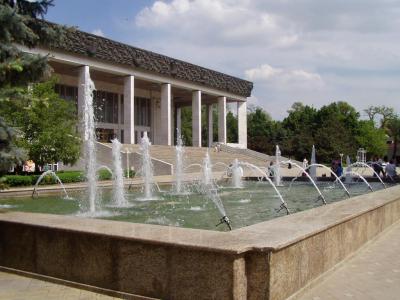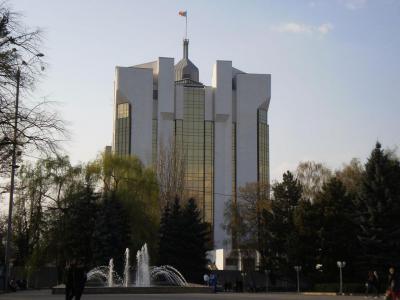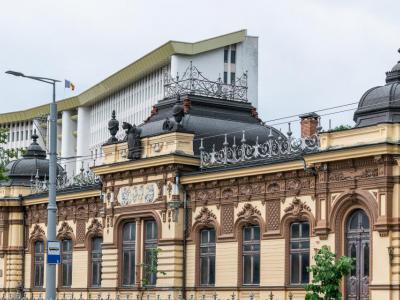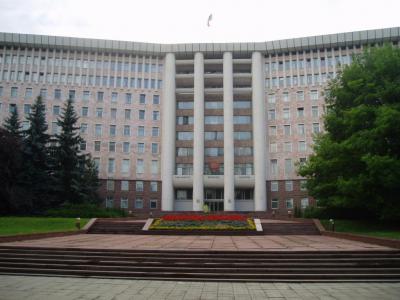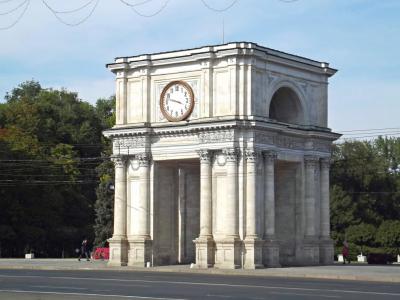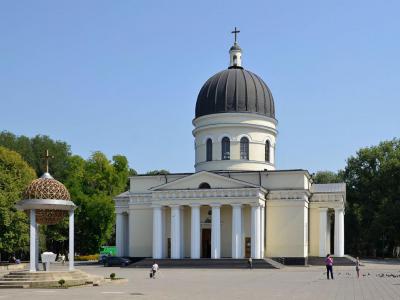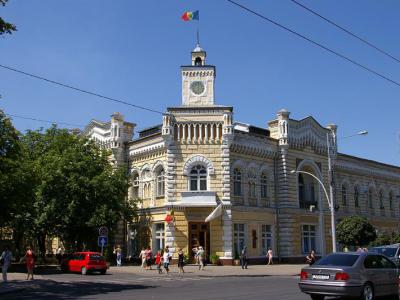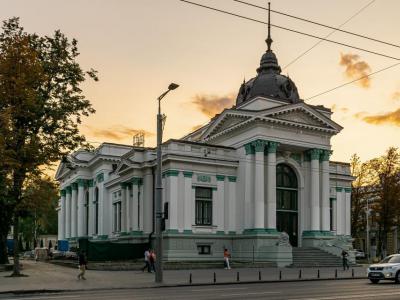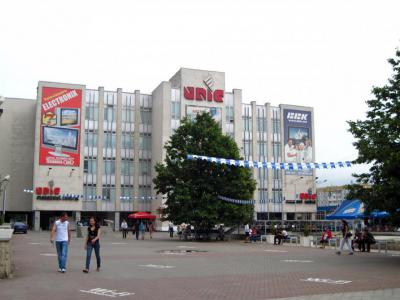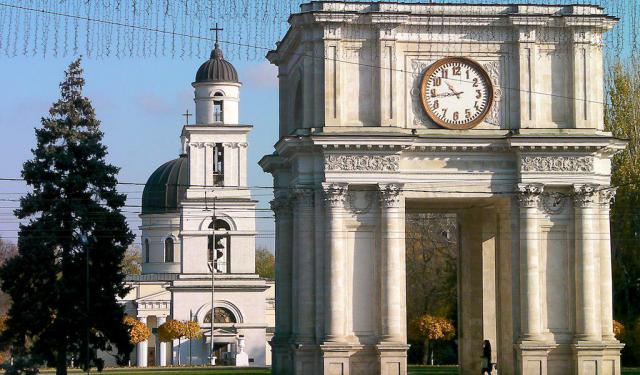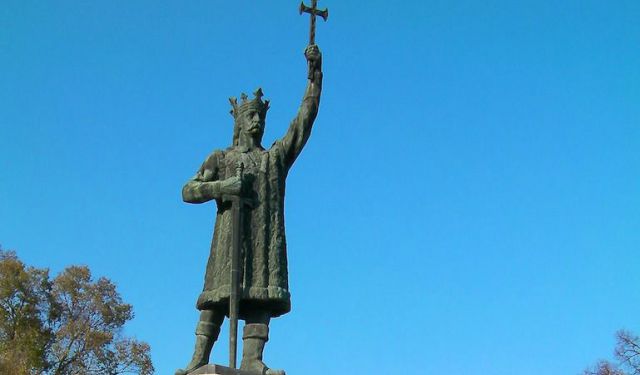
Stefan cel Mare Blvd Walk (Self Guided), Chisinau
Stefan cel Mare Boulevard is arguably the most prominent streets of the Moldovan capital. The 3.8-km thoroughfare is lined with numerous buildings of social and political importance, cultural institutions, shops, and restaurants.
Historically, it is believed to have stemmed from the road that led into the city from the Russian military camp stationed to the west of Chisinau in 1789. Long before the city plan was adopted by Russian Emperor Alexander II in 1834, the construction of the Nativity Cathedral started together with the Public Garden (now known as Stefan cel Mare Park) and many other locations nearby.
Over the years, the street has changed several names, starting from Millionnaia in the early 19th century to Moskovskaia (between 1840 and 1877), followed by Aleksandrovskaia (between 1877 and 1924), then Alexandru cel Bun Boulevard (between 1924 and 1931), King Carol II Boulevard (between 1931 and 1944), Lenin Street (between 1944 and 1952) and Lenin Boulevard (between 1952 and 1990) until finally, following the country's independence in 1991, becoming Stefan cel Mare Boulevard – named after of the ancient ruler of Moldova, prince Stephen the Great during 1457 to 1504.
Largely rebuilt after WWII, the boulevard had some of the buildings keep their original appearance while their function had changed.
The City Hall – home to Chisinau's municipal administration since 1951; originally constructed in 1901, was rebuilt in 1945–1948. Organ Hall – first built in 1901 to house a bank; converted into a concert hall in 1978. The Mihai Eminescu National Theater – appeared in 1920 as the Palace of Culture; restructured in 1946–1953 to accommodate the theater.
During the 1970s–80s, several new buildings were added to the scape, including:
The National Opera and Ballet Theatre, established in 1957 – moved to the new location in 1980. Presidential Palace – headquarters of the Presidential Apparatus of the Republic of Moldova; constructed in 1984. Parliament Building – seat of the Moldovan Parliament; originally built to house the Central Committee of the Communist Party of MSSR in 1976-1979.
To explore Chisinau's main artery and its attractions in more detail, take this self-guided walk.
Historically, it is believed to have stemmed from the road that led into the city from the Russian military camp stationed to the west of Chisinau in 1789. Long before the city plan was adopted by Russian Emperor Alexander II in 1834, the construction of the Nativity Cathedral started together with the Public Garden (now known as Stefan cel Mare Park) and many other locations nearby.
Over the years, the street has changed several names, starting from Millionnaia in the early 19th century to Moskovskaia (between 1840 and 1877), followed by Aleksandrovskaia (between 1877 and 1924), then Alexandru cel Bun Boulevard (between 1924 and 1931), King Carol II Boulevard (between 1931 and 1944), Lenin Street (between 1944 and 1952) and Lenin Boulevard (between 1952 and 1990) until finally, following the country's independence in 1991, becoming Stefan cel Mare Boulevard – named after of the ancient ruler of Moldova, prince Stephen the Great during 1457 to 1504.
Largely rebuilt after WWII, the boulevard had some of the buildings keep their original appearance while their function had changed.
The City Hall – home to Chisinau's municipal administration since 1951; originally constructed in 1901, was rebuilt in 1945–1948. Organ Hall – first built in 1901 to house a bank; converted into a concert hall in 1978. The Mihai Eminescu National Theater – appeared in 1920 as the Palace of Culture; restructured in 1946–1953 to accommodate the theater.
During the 1970s–80s, several new buildings were added to the scape, including:
The National Opera and Ballet Theatre, established in 1957 – moved to the new location in 1980. Presidential Palace – headquarters of the Presidential Apparatus of the Republic of Moldova; constructed in 1984. Parliament Building – seat of the Moldovan Parliament; originally built to house the Central Committee of the Communist Party of MSSR in 1976-1979.
To explore Chisinau's main artery and its attractions in more detail, take this self-guided walk.
How it works: Download the app "GPSmyCity: Walks in 1K+ Cities" from Apple App Store or Google Play Store to your mobile phone or tablet. The app turns your mobile device into a personal tour guide and its built-in GPS navigation functions guide you from one tour stop to next. The app works offline, so no data plan is needed when traveling abroad.
Stefan cel Mare Blvd Walk Map
Guide Name: Stefan cel Mare Blvd Walk
Guide Location: Moldova » Chisinau (See other walking tours in Chisinau)
Guide Type: Self-guided Walking Tour (Sightseeing)
# of Attractions: 14
Tour Duration: 2 Hour(s)
Travel Distance: 3.6 Km or 2.2 Miles
Author: ann
Sight(s) Featured in This Guide:
Guide Location: Moldova » Chisinau (See other walking tours in Chisinau)
Guide Type: Self-guided Walking Tour (Sightseeing)
# of Attractions: 14
Tour Duration: 2 Hour(s)
Travel Distance: 3.6 Km or 2.2 Miles
Author: ann
Sight(s) Featured in This Guide:
- National Opera and Ballet Theatre
- Presidential Palace
- Transfiguration of the Savior Church
- Hertz and Kligman House
- Parliament Building
- Stefan the Great Monument
- Triumphal Arch
- Bell Tower
- Nativity Cathedral
- City Hall
- Organ Hall
- National Theater Mihai Eminescu
- Central Market (Piaţa Centrală)
- UNIC Shopping Center
1) National Opera and Ballet Theatre
Overlooking the Stefan cel Mare Boulevard in Chisinau is one of major opera and ballet theaters in Eastern Europe – the National Opera and Ballet of Moldova. After the collapse of the Soviet Union in the early 90s, this theater was one of the few on the post-Soviet territory to retain its ballet, opera and orchestra troupe, complete with all the soloists and chorus, as well as the equipment.
In 2012, the theater was named after the renowned local opera diva Maria Bieșu, whose artistic excellence brought her international recognition; from 1965 to 1967 she had performed at the La Scala Opera in Milan.
Presently, the theater employs a group of talented singers and dancers, both seasoned professionals and young graduates from the local Choreographic College and Music Conservatory. In recent years, the company has toured far and wide, throughout Europe and further afield, including countries like Italy, Romania, Bulgaria, Portugal, France, Spain, Britain, and others. Given the breadth of their repertoire, the Theater has no problem catering to the wishes of foreign impresarios, focused on specific national tastes.
Why You Should Visit:
The theater is regularly sold out, which only adds to the atmosphere; ticket prices are usually 10% of what you pay for a similar show in London, so you get excellent value for money.
Ticket Office Hours:
Mon-Fri: 11am-6pm; Sat, Sun: 11am-4pm
With lunch break between 1-2pm
In 2012, the theater was named after the renowned local opera diva Maria Bieșu, whose artistic excellence brought her international recognition; from 1965 to 1967 she had performed at the La Scala Opera in Milan.
Presently, the theater employs a group of talented singers and dancers, both seasoned professionals and young graduates from the local Choreographic College and Music Conservatory. In recent years, the company has toured far and wide, throughout Europe and further afield, including countries like Italy, Romania, Bulgaria, Portugal, France, Spain, Britain, and others. Given the breadth of their repertoire, the Theater has no problem catering to the wishes of foreign impresarios, focused on specific national tastes.
Why You Should Visit:
The theater is regularly sold out, which only adds to the atmosphere; ticket prices are usually 10% of what you pay for a similar show in London, so you get excellent value for money.
Ticket Office Hours:
Mon-Fri: 11am-6pm; Sat, Sun: 11am-4pm
With lunch break between 1-2pm
2) Presidential Palace
Presidential Palace in Chisinau is a relatively new object of national importance. Erected from 1984-1987, this glass-clad building was designed originally to accommodate the Supreme Council of the Moldavian Soviet Republic. After Moldova gained independence in 1991, the Palace was converted to house the office of the country's President.
The building was heavily damaged during protest on April 7, 2009, which was held against the then President Vladimir Voronin. The building had to be closed off for several years after that, pending reparation. During the tenure of President Igor Dodon, the Palace was renovated with the help of the Turkish government and was finally reopened, on October 17, 2018, in the presence of Turkish President Recep Tayyip Erdogan.
The building was heavily damaged during protest on April 7, 2009, which was held against the then President Vladimir Voronin. The building had to be closed off for several years after that, pending reparation. During the tenure of President Igor Dodon, the Palace was renovated with the help of the Turkish government and was finally reopened, on October 17, 2018, in the presence of Turkish President Recep Tayyip Erdogan.
3) Transfiguration of the Savior Church
Chisinau may be small a city but it is still not short of legendary structures attesting to Moldova's rich and vibrant past.
Located in the heart of the capital, the Church of Schimbarea la Faţă a Mântuitorului is one of the finest such structures. It is located between the Parliament and the Presidential Administration, and represents a splendid piece of architecture which comprises grandeur, elegance and architectural poise.
The Schimbarea la Faţă a Mântuitorului [the Transfiguration of the Christ] Church was built between 1898 and 1902, thanks to a large donation made by Governor General Constantin Alexandrov.
The same year it was built, the church was sanctified and opened for public service. During the years of the Communist rule, when Moldova was part of the Soviet Union, the church was used as a planetarium. Since Moldova gained its independence in 1992, the building has been serving the original purpose.
Other than rich historic past, the church is particularly noted for its impeccable architecture - elegant exterior and awe inspiring interior filled with elaborate murals, ornate sculptures and other beautiful decorations. Designed by architect Michael Seroţinski, the building features a spectacular Russian-Byzantine style, with an elaborate closed Greek Cross plan.
Located in the heart of the capital, the Church of Schimbarea la Faţă a Mântuitorului is one of the finest such structures. It is located between the Parliament and the Presidential Administration, and represents a splendid piece of architecture which comprises grandeur, elegance and architectural poise.
The Schimbarea la Faţă a Mântuitorului [the Transfiguration of the Christ] Church was built between 1898 and 1902, thanks to a large donation made by Governor General Constantin Alexandrov.
The same year it was built, the church was sanctified and opened for public service. During the years of the Communist rule, when Moldova was part of the Soviet Union, the church was used as a planetarium. Since Moldova gained its independence in 1992, the building has been serving the original purpose.
Other than rich historic past, the church is particularly noted for its impeccable architecture - elegant exterior and awe inspiring interior filled with elaborate murals, ornate sculptures and other beautiful decorations. Designed by architect Michael Seroţinski, the building features a spectacular Russian-Byzantine style, with an elaborate closed Greek Cross plan.
4) Hertz and Kligman House
The Kligman House was built in 1898 by Chisinau lawyer Moses Kligman on the site of a regular town house. The new building had an elegant asymmetrical facade and the entrance, decorated with two Ionic columns, moved off-center to the right, perfectly balanced by the facade architecture featuring a number of relief poles between the windows with carved cornices, echoeing the columns at the entrance. A little later - in 1903, the titular counselor Vladimir Hertz built a residence in the place previously occupied by an orphanage, held by landowner Iorgu Balş.
Experts say the Hertz project was done by Austrian architect Heinrich Lonski. The building resembles a birthday cake for its protruding from the roof risolits, and the roof featuring somewhat bizarre looking domes. The exterior decoration - ornate molding, vases on top of the facade, richly adorned with bas-reliefs in the form of floral ornament and allegorical figures - completes the front outlook. Inside the house was once rife with decorative elements too - walls and ceilings adorned with frescoes on mythological themes, lavishly decorated with gilded moldings. Inspired by Viennese Baroque and Art Nouveau, with a touch of Moorish style, the building represents a wonderful piece of eclecticism, so typical of the Chisinau architecture at the turn of the century.
During the Soviet period, the Hertz house was linked to the neighboring and more sober looking Kligman house by a gallery.
Experts say the Hertz project was done by Austrian architect Heinrich Lonski. The building resembles a birthday cake for its protruding from the roof risolits, and the roof featuring somewhat bizarre looking domes. The exterior decoration - ornate molding, vases on top of the facade, richly adorned with bas-reliefs in the form of floral ornament and allegorical figures - completes the front outlook. Inside the house was once rife with decorative elements too - walls and ceilings adorned with frescoes on mythological themes, lavishly decorated with gilded moldings. Inspired by Viennese Baroque and Art Nouveau, with a touch of Moorish style, the building represents a wonderful piece of eclecticism, so typical of the Chisinau architecture at the turn of the century.
During the Soviet period, the Hertz house was linked to the neighboring and more sober looking Kligman house by a gallery.
5) Parliament Building
Built during the Soviet period, from 1976-1979, this former headquarters of the once mighty Communist Party today houses Moldova's national parliament. The building features the shape of an open book with the central part of its façade supported by four high-standing vertical columns. In the spring of 2009 the building came under attack by rioting students in what came to be known as the "Twitter Revolution". After substantial repairs done in the following three years, the Parliament moved back in and resumed work in February 2014.
6) Stefan the Great Monument (must see)
The bronze monument of Stefan the Great (or Stefan cel Mare as it's known locally) outside the main entrance to the park bearing the same name in downtown Chisinau commemorates Moldova's national hero – the ancient ruler, who, in the 15th century, successfully defended the country from Turkish invasion. The statue was cast in Bucharest in the early 20th century and was intended to replace the monument to the Russian Emperor Alexander II which had previously stood in this place and was demolished by Romanian authorities after Moldova had joined the Romanian Kingdom in 1918.
The sculpture was created by Alexandru Plamadeala who had traveled far and wide, prior to starting the job, in order to find a portrait of Stefan cel Mare. They say, the sculptor made three different copies of the monument, one of which stands today. Over the years, the sculpture has been moved several times from place to place. Shortly before the Soviet invasion of Bessarabia in 1940, it was taken to Vaslui in the eastern part of Romania, and then returned to Chisinau in 1942. Then, in 1944, it was once again dispatched to Romania. Finally, after a very long while, in 1989, the monument was restored in its original place in Chisinau. Today, the sculpture represents one of the top tourist sights in Moldovan capital and is a popular meeting point with locals, often visited by foreign guests, wedding couples and others.
The sculpture was created by Alexandru Plamadeala who had traveled far and wide, prior to starting the job, in order to find a portrait of Stefan cel Mare. They say, the sculptor made three different copies of the monument, one of which stands today. Over the years, the sculpture has been moved several times from place to place. Shortly before the Soviet invasion of Bessarabia in 1940, it was taken to Vaslui in the eastern part of Romania, and then returned to Chisinau in 1942. Then, in 1944, it was once again dispatched to Romania. Finally, after a very long while, in 1989, the monument was restored in its original place in Chisinau. Today, the sculpture represents one of the top tourist sights in Moldovan capital and is a popular meeting point with locals, often visited by foreign guests, wedding couples and others.
7) Triumphal Arch (must see)
Also known as the Holy Gate, the Triumphal Arch is yet another historic monument in the heart of Chisinau. It was built in 1846 to commemorate victory of the Russian forces over the Turkish Army in the 1820s. The Arch overlooks the Government House on Stefan cel Mare Boulevard from across the Great National Assembly Square.
The structure has a classic, square-shaped form, 13 meters in height and is distinctly divided into two tiers. The lower tier comprises four sturdy pylons, ornately decorated with classic Corinthian columns, which give the construction its regal look. It also features a beautiful clock on the side, which chimes every fifteen minutes.
Aside from its architectural value, the Arch is also noted for its fascinating history. After the Russians defeated Turks in 1829, Tsar Nikolai I, acting on request of General Vorontsov, one of the most prominent war veterans, ordered to make bells from the captured Turkish canons. These bells were to be installed inside the Arch. However, upon their completion, the bells proved to be too big for the Arch and therefore a separate belfry had to be constructed nearby specially for them.
Why You Should Visit:
Historical significance aside, it is quite refreshing to find a monument of this type in Moldova. You can't go in it or up it, but it gives a little relief to the city itself.
Quite successful in its miniature form and a must-see of the Moldavian Champs-Élysées as it marks the dead center of the city.
Tip:
Take a walk to see it at dusk, when it is beautifully lit. You can also spend some time in the very nice park nearby.
The structure has a classic, square-shaped form, 13 meters in height and is distinctly divided into two tiers. The lower tier comprises four sturdy pylons, ornately decorated with classic Corinthian columns, which give the construction its regal look. It also features a beautiful clock on the side, which chimes every fifteen minutes.
Aside from its architectural value, the Arch is also noted for its fascinating history. After the Russians defeated Turks in 1829, Tsar Nikolai I, acting on request of General Vorontsov, one of the most prominent war veterans, ordered to make bells from the captured Turkish canons. These bells were to be installed inside the Arch. However, upon their completion, the bells proved to be too big for the Arch and therefore a separate belfry had to be constructed nearby specially for them.
Why You Should Visit:
Historical significance aside, it is quite refreshing to find a monument of this type in Moldova. You can't go in it or up it, but it gives a little relief to the city itself.
Quite successful in its miniature form and a must-see of the Moldavian Champs-Élysées as it marks the dead center of the city.
Tip:
Take a walk to see it at dusk, when it is beautifully lit. You can also spend some time in the very nice park nearby.
8) Bell Tower
Situated directly behind the Holy Gates, opposite the Cathedral, is a beautiful bell tower, an important religious and historic site in Chisinau.
This Belfry is the exact replica of its predecessor that was built on this site in the 1830s (along with the nearby Cathedral). The original tower was fitted with the bells made from the Turkish cannons captured during the Russo-Turkish war of 1828-1829.
Sadly, the first belfry was demolished in 1962, during the Soviet reign, under Nikita Khrushchev, and was replaced with a flower bed. Officially, this was done in a bid to prevent anybody from using the tower as a firing position should anyone ever contemplated murdering government officials sitting in the Government House on the opposite side of the square.
In the post-Soviet era, in 1998, the bell tower was rebuilt. It stands four stories high, has several bells at the top, and a small chapel on the ground floor.
Tip:
Note the surrounding flowerbeds; if you want to buy flowers, check out the stalls on the side of the park.
This Belfry is the exact replica of its predecessor that was built on this site in the 1830s (along with the nearby Cathedral). The original tower was fitted with the bells made from the Turkish cannons captured during the Russo-Turkish war of 1828-1829.
Sadly, the first belfry was demolished in 1962, during the Soviet reign, under Nikita Khrushchev, and was replaced with a flower bed. Officially, this was done in a bid to prevent anybody from using the tower as a firing position should anyone ever contemplated murdering government officials sitting in the Government House on the opposite side of the square.
In the post-Soviet era, in 1998, the bell tower was rebuilt. It stands four stories high, has several bells at the top, and a small chapel on the ground floor.
Tip:
Note the surrounding flowerbeds; if you want to buy flowers, check out the stalls on the side of the park.
9) Nativity Cathedral (must see)
The Nativity Cathedral in Chisinau is a fine piece of Russian architecture, dating back to the early 19th century. Just like most religious sites in the city during the Soviet period, the Cathedral building was converted to a secular use and served as an exhibition center. Following the collapse of the Soviet Union, it has resumed service as a place of worship for the local Orthodox congregation.
Construction on the Cathedral was commissioned by Prince Mikhail Semyonovich Vorontsov, the governor-general of Novorossiya (or New Russia) region of the Russian Empire back in the 1830s, and was led by architect Avraam Melnikov, one of the country's finest architects at the time. Given the importance of the project, great care was taken to ensure the building's elegant, regal and timeless appearance. As such, the Cathedral features eclectic style, a combination of Byzantine elements with a hint of Renaissance on a Greek Cross, which is a perfect brew for neoclassical design.
Over the centuries, this remarkable edifice has sustained multiple damages caused by wars and political upheavals following the demise of, first, the Russian Empire and then the Soviet Union. Today, the Cathedral stands as the main temple of the Russian Orthodox Church in Chisinau and is a definite must-see attraction for any architecture buff visiting the city.
Why You Should Visit:
Set in front of the nice square (good for meditating and/or people watching), the structure appears quite large and simple from the outside, but on the inside it is rather small, yet brightly lit – a perfect example of Orthodox cathedral architecture.
Construction on the Cathedral was commissioned by Prince Mikhail Semyonovich Vorontsov, the governor-general of Novorossiya (or New Russia) region of the Russian Empire back in the 1830s, and was led by architect Avraam Melnikov, one of the country's finest architects at the time. Given the importance of the project, great care was taken to ensure the building's elegant, regal and timeless appearance. As such, the Cathedral features eclectic style, a combination of Byzantine elements with a hint of Renaissance on a Greek Cross, which is a perfect brew for neoclassical design.
Over the centuries, this remarkable edifice has sustained multiple damages caused by wars and political upheavals following the demise of, first, the Russian Empire and then the Soviet Union. Today, the Cathedral stands as the main temple of the Russian Orthodox Church in Chisinau and is a definite must-see attraction for any architecture buff visiting the city.
Why You Should Visit:
Set in front of the nice square (good for meditating and/or people watching), the structure appears quite large and simple from the outside, but on the inside it is rather small, yet brightly lit – a perfect example of Orthodox cathedral architecture.
10) City Hall
Undoubtedly one of the few old buildings in Chisinau that are fit to captivate the eye of any beholder is the City Hall. An architectural landmark in its own right, this building stands majestically on the corner of Stefan cel Mare Boulevard and Vlaicu Parcalab Street.
The two-story edifice was built in the early 20th century to a design by Alexander Bernardazzi, featuring classic Gothic Italian style. A commemorative plaque to the architect can be found on the front wall.
The City Hall building is lavishly embellished with medieval Gothic- and Renaissance-style elements, revealing heavy influence of Italian decorative tradition. The structure suffered terrible damage during the Second World War and required painstaking efforts to regain its former glory.
The building has a quad-shaped plan with arched windows on elegant façade, ornately crowned by triangular pediments. The walls, draped in a faint shade of beige and white, are marvelously complemented by an elegant clock tower at the top.
The two-story edifice was built in the early 20th century to a design by Alexander Bernardazzi, featuring classic Gothic Italian style. A commemorative plaque to the architect can be found on the front wall.
The City Hall building is lavishly embellished with medieval Gothic- and Renaissance-style elements, revealing heavy influence of Italian decorative tradition. The structure suffered terrible damage during the Second World War and required painstaking efforts to regain its former glory.
The building has a quad-shaped plan with arched windows on elegant façade, ornately crowned by triangular pediments. The walls, draped in a faint shade of beige and white, are marvelously complemented by an elegant clock tower at the top.
11) Organ Hall
Originally, the Organ Hall building was designed as the City Bank. In 1902 the Municipal Council of Chisinau launched a competition of architectural projects with a prize of 1,500 rubles, which was a fairly large amount in those days. The winner – engineer Mikhail Chekerul-Kush, aged 38 at that time – received commendation from the famous architect Alexander Bernardazzi himself.
In Soviet times, the building housed the regional office of the USSR State Bank. The decision to turn it into a concert hall was taken by the then leader of the Moldavian Soviet Socialist Republic, Ivan Bodiul. His daughter, Svetlana Bodiul, was an accomplished organist who had graduated from the Moscow Conservatory and long dreamed of a decent venue for classical music in her hometown. Reconstruction started in 1975 and lasted until 1978, led by architect Y.L. Leonchenko.
The first concert was held on 16 September 1978 played by prominent Soviet organist Harry Y. Grodberg. That concert also featured local opera diva Maria Bieshu, cellist Ion Josan, Svetlana Bodiul herself, and the choir conducted by Veronica Garstea.
Many prominent musicians have played the Organ Hall ever since. Among them Igor Oistrakh, Vladimir Spivakov, the "Madrigal" Moscow Philharmonic Ensemble, the National Chamber Orchestra of Russia under Viktor Tretyakov, and many other stars of classical organ and instrumental chamber music from France, Germany, Italy, Spain, Romania, the Czech Republic, the USA, and other countries. Annually, the Organ Hall hosts a variety of festivals, competitions and art exhibitions. Among the most important cultural events held here are the International Music Festival "Martisor", the International Classical Music Festival "Crescendo", the "New Music Days" festival of contemporary classical music, as well as national and international competitions of instrumental performers and singers.
Why You Should Visit:
This place provides some good acoustics! At the least, one of the most accessible, unlikely to be discovered, concert halls in all of Eastern Europe.
Although the recently renovated building is not very large, it looks almost like a palace, so you'll have a neat spot for taking pictures as well.
Tip:
Don't miss the very nice antique store on the left upon entering! It is worth visiting. Also, the prices are okay for both the shop and for the concerts.
In Soviet times, the building housed the regional office of the USSR State Bank. The decision to turn it into a concert hall was taken by the then leader of the Moldavian Soviet Socialist Republic, Ivan Bodiul. His daughter, Svetlana Bodiul, was an accomplished organist who had graduated from the Moscow Conservatory and long dreamed of a decent venue for classical music in her hometown. Reconstruction started in 1975 and lasted until 1978, led by architect Y.L. Leonchenko.
The first concert was held on 16 September 1978 played by prominent Soviet organist Harry Y. Grodberg. That concert also featured local opera diva Maria Bieshu, cellist Ion Josan, Svetlana Bodiul herself, and the choir conducted by Veronica Garstea.
Many prominent musicians have played the Organ Hall ever since. Among them Igor Oistrakh, Vladimir Spivakov, the "Madrigal" Moscow Philharmonic Ensemble, the National Chamber Orchestra of Russia under Viktor Tretyakov, and many other stars of classical organ and instrumental chamber music from France, Germany, Italy, Spain, Romania, the Czech Republic, the USA, and other countries. Annually, the Organ Hall hosts a variety of festivals, competitions and art exhibitions. Among the most important cultural events held here are the International Music Festival "Martisor", the International Classical Music Festival "Crescendo", the "New Music Days" festival of contemporary classical music, as well as national and international competitions of instrumental performers and singers.
Why You Should Visit:
This place provides some good acoustics! At the least, one of the most accessible, unlikely to be discovered, concert halls in all of Eastern Europe.
Although the recently renovated building is not very large, it looks almost like a palace, so you'll have a neat spot for taking pictures as well.
Tip:
Don't miss the very nice antique store on the left upon entering! It is worth visiting. Also, the prices are okay for both the shop and for the concerts.
12) National Theater Mihai Eminescu
The National Theater Mihai Eminescu was established on October 10, 1920 by a group of prominent Romanian cultural and public figures, led by the Minister of Bessarabia in the Government of Romania, Sergiu T. Niţă. The troupe worked only one season, delivering 25 performances. In 1935, by ministerial order, theaters in Chisinau, Craiova and Chernivtsi were closed for financial reasons. Although short-lived, the first National Theater in Chisinau has made an important contribution to the culture of Bessarabia.
In 1933, the Moldavian National Theater was founded in the capital of the Moldavian Autonomous Soviet Socialist Republic, Tiraspol. After June 28, 1940, when the territory between the Prut and the Dniester rivers was incorporated into the Soviet Union, on the basis of the Tiraspol theater a new Moldavian State Theater was formed in Chisinau [then Kishinev]. In 1945, it was named after Alexander Pushkin. Shortly afterward, the majority of the Tiraspol troupe moved to Chisinau to join the local artists. The present building was constructed in 1954 and is now counted among the most treasured architectural monuments in the city. Designed by renowned architect Galadjeva, it boasts a grand neoclassic façade, which gives it a timeless appeal. The interior - credited to architects V.F. Alexandrov and V.P. Smirnov - is regal, elegant and opulent. With the walls painted with mural depicting ‘Hora’, and the balconies and lodges having ornate and delicate decoration, the interior of the theater is nothing short of splendour.
In 1994, the theater got the status of national and was renamed Mihai Eminescu. A new page in its history has been opened by talented young actors - students of renowned theater schools in Moscow, Tbilisi, Iasi and Chisinau.
In 1933, the Moldavian National Theater was founded in the capital of the Moldavian Autonomous Soviet Socialist Republic, Tiraspol. After June 28, 1940, when the territory between the Prut and the Dniester rivers was incorporated into the Soviet Union, on the basis of the Tiraspol theater a new Moldavian State Theater was formed in Chisinau [then Kishinev]. In 1945, it was named after Alexander Pushkin. Shortly afterward, the majority of the Tiraspol troupe moved to Chisinau to join the local artists. The present building was constructed in 1954 and is now counted among the most treasured architectural monuments in the city. Designed by renowned architect Galadjeva, it boasts a grand neoclassic façade, which gives it a timeless appeal. The interior - credited to architects V.F. Alexandrov and V.P. Smirnov - is regal, elegant and opulent. With the walls painted with mural depicting ‘Hora’, and the balconies and lodges having ornate and delicate decoration, the interior of the theater is nothing short of splendour.
In 1994, the theater got the status of national and was renamed Mihai Eminescu. A new page in its history has been opened by talented young actors - students of renowned theater schools in Moscow, Tbilisi, Iasi and Chisinau.
13) Central Market (Piaţa Centrală)
Just like any other capital, Chisinau has no shortage of shopping venues. The Central Market (Russian: Tsentral'nii Rinok / Romanian: Piata Centrala) is the largest and busiest agri-food market in the city, if not the whole country. It covers an area of 3.5 hectares occupying 2x2 city blocks between Armeneasca and Tighina Streets, Stefan cel Mare Blvd and Mitropolit Varlaam Street.
Originally called New Bazaar upon establishment in 1825, the market stood out for its elegant wooden architecture. Also added to the appeal, especially among vendors, the initial tax-free policy in force for almost 80 years. In 1886-1887, following the municipal order, the entire market was redone in stone. In 1941, amid the looming occupation by the Nazis, the retreating Soviet troops blasted the whole place, lest it fell into the enemy's hands. After the war, the market was restored together with the rest of the city, and was subsequently renamed Central Market.
Here you can find absolutely everything, from suitcases to electronics, clothing, jewelry, household goods and appliances, plus the famous Bucuria-made sweets, cookies and desserts sold at the outer stalls. Further inward you will be delighted by the beautiful displays of a tremendous variety of fresh fruits and vegetables, as well as meats, fish, dried fruits, grains, and the locally-made sheep and goat cheeses. Good and cheap street food and snacks are also in rich supply.
Particularly noteworthy are the traditional Moldovan items, like the woven baskets, căciuli (handmade sheepskin hats), and other curious things.
Why You Should Visit:
If asked “what can I see and do to experience local tradition?” – Piata Centrala is that place in Chisinau. The locals come here to buy their stuff, so it must be good.
For those with a taste for open-air marketplaces and keen to feel the “real life” in Chisinau, this place is a must! The atmosphere is crowded, noisy and old world.
Tips:
- English is not widely spoken. Moldovan/Romanian and Russian are the standard.
- Cash is the king, so bring your Lei.
- This is a traditional market/bazaar, so keep an eye on your valuables like at any other close quarter place with a lot of foot traffic.
Originally called New Bazaar upon establishment in 1825, the market stood out for its elegant wooden architecture. Also added to the appeal, especially among vendors, the initial tax-free policy in force for almost 80 years. In 1886-1887, following the municipal order, the entire market was redone in stone. In 1941, amid the looming occupation by the Nazis, the retreating Soviet troops blasted the whole place, lest it fell into the enemy's hands. After the war, the market was restored together with the rest of the city, and was subsequently renamed Central Market.
Here you can find absolutely everything, from suitcases to electronics, clothing, jewelry, household goods and appliances, plus the famous Bucuria-made sweets, cookies and desserts sold at the outer stalls. Further inward you will be delighted by the beautiful displays of a tremendous variety of fresh fruits and vegetables, as well as meats, fish, dried fruits, grains, and the locally-made sheep and goat cheeses. Good and cheap street food and snacks are also in rich supply.
Particularly noteworthy are the traditional Moldovan items, like the woven baskets, căciuli (handmade sheepskin hats), and other curious things.
Why You Should Visit:
If asked “what can I see and do to experience local tradition?” – Piata Centrala is that place in Chisinau. The locals come here to buy their stuff, so it must be good.
For those with a taste for open-air marketplaces and keen to feel the “real life” in Chisinau, this place is a must! The atmosphere is crowded, noisy and old world.
Tips:
- English is not widely spoken. Moldovan/Romanian and Russian are the standard.
- Cash is the king, so bring your Lei.
- This is a traditional market/bazaar, so keep an eye on your valuables like at any other close quarter place with a lot of foot traffic.
14) UNIC Shopping Center
Not so long ago, those nostalgic for the Soviet legacy in Chisinau could more or less satisfy their passion whilst visiting UNIC shopping center. The store was founded in 1945, being one of the first commercial enterprises in the country, and was for many years, up until the fall of the Soviet Union in the early 1990s, known as Tsentral'nii Univermag (Russian for Central Supermarket).
A decade prior to that the store had expanded and moved to its new (current) location. Curiously enough, even as recently as the 2010s, entering here still made one feel like stepping back in time – circa 1984 or earlier – finding all sorts of old-fashioned gifts, souvenirs, cosmetics, Soviet-style appliances, crockery and retro furniture, sewing items, handicrafts, clothing, bags and leather goods on sale. The onsite cafe also added to the impression with waitresses serving same kind of bagels they did 25 years ago. Only the presence of plasma TVs broke the illusion.
Today things have changed courtesy of the European-based designer firm that has created phased redevelopment and extension of UNIC shopping center to house a new food court and external terraces, a new office tower and an underground car park, plus the regeneration of the adjacent public plaza. Some of this has already materialized; the rest is due over the next few years.
Presently, the historic 5-story shopping centre delights visitors with a solid range of merchandise. Each floor carries a certain variety to suit different tastes and purposes: 1st (ground) floor – accessories, jewelry and cosmetics; 2nd floor – women's clothes and footwear; 3rd floor – DIN INIMA brand products by Moldovan manufacturers, including children's clothing & footwear, and toys; 4th floor - menswear and accessories; 5th floor – fabrics and goods for home.
Those keen on traditional products, should check out the Moldovan-made long-hair carpets (cerga, niturca, satranca), dolls, pottery (wine jugs, bowls), wood carvings and woven baskets.
A decade prior to that the store had expanded and moved to its new (current) location. Curiously enough, even as recently as the 2010s, entering here still made one feel like stepping back in time – circa 1984 or earlier – finding all sorts of old-fashioned gifts, souvenirs, cosmetics, Soviet-style appliances, crockery and retro furniture, sewing items, handicrafts, clothing, bags and leather goods on sale. The onsite cafe also added to the impression with waitresses serving same kind of bagels they did 25 years ago. Only the presence of plasma TVs broke the illusion.
Today things have changed courtesy of the European-based designer firm that has created phased redevelopment and extension of UNIC shopping center to house a new food court and external terraces, a new office tower and an underground car park, plus the regeneration of the adjacent public plaza. Some of this has already materialized; the rest is due over the next few years.
Presently, the historic 5-story shopping centre delights visitors with a solid range of merchandise. Each floor carries a certain variety to suit different tastes and purposes: 1st (ground) floor – accessories, jewelry and cosmetics; 2nd floor – women's clothes and footwear; 3rd floor – DIN INIMA brand products by Moldovan manufacturers, including children's clothing & footwear, and toys; 4th floor - menswear and accessories; 5th floor – fabrics and goods for home.
Those keen on traditional products, should check out the Moldovan-made long-hair carpets (cerga, niturca, satranca), dolls, pottery (wine jugs, bowls), wood carvings and woven baskets.
Walking Tours in Chisinau, Moldova
Create Your Own Walk in Chisinau
Creating your own self-guided walk in Chisinau is easy and fun. Choose the city attractions that you want to see and a walk route map will be created just for you. You can even set your hotel as the start point of the walk.
Chisinau Introduction Walking Tour
Chisinau is the capital of Moldova, a small nation in Eastern Europe landlocked between Romania and Ukraine. For many years this land had been part of the Russian Empire and then the Soviet Union, until it finally gained independence in 1991. For this reason the city is also often referred to as Kishinev, which is the Russian version of the name.
While the true origin of the name is unclear,... view more
Tour Duration: 2 Hour(s)
Travel Distance: 2.4 Km or 1.5 Miles
While the true origin of the name is unclear,... view more
Tour Duration: 2 Hour(s)
Travel Distance: 2.4 Km or 1.5 Miles
Best Wine and Brandy Shops
Given the lack of stunning scenery – no turquoise waters or snow-clad mountains – Moldova is a country not overrun by tourists. Still, those who come here, usually do so to taste the local wines and brandies – Moldova is a seasoned grape and spirit producer. The locals are very lovable and hospitable people, genuinely ready to delight strangers with their internationally-renowned booze. Here... view more
Tour Duration: 1 Hour(s)
Travel Distance: 3.0 Km or 1.9 Miles
Tour Duration: 1 Hour(s)
Travel Distance: 3.0 Km or 1.9 Miles
Bernardazzi Architecture Walking Tour
Talented people are often able to leave their mark in the hearts of the posterity long after they are gone. Centuries fly but the power of the beauty persists, especially if set in the stones of the buildings designed by distinguished architects. Moldova's capital is blessed in this respect as the place associated with Alexander Bernardazzi, a Russian architect of Swiss-Italian descent who... view more
Tour Duration: 1 Hour(s)
Travel Distance: 2.4 Km or 1.5 Miles
Tour Duration: 1 Hour(s)
Travel Distance: 2.4 Km or 1.5 Miles
Chisinau Historical Sites
Although the history of Chisinau accounts for just over 500 years, whilst that of Moldova, as a nation, even less than that – since 1991, Moldovan culture and language are deeply rooted in the ancient Roman tradition. Just as the Eternal City, Chisinau rests on seven hills – in the valley of the River Bic, and has a replica statue of the Capitoline Wolf in the downtown area. Whereas most of... view more
Tour Duration: 3 Hour(s)
Travel Distance: 5.5 Km or 3.4 Miles
Tour Duration: 3 Hour(s)
Travel Distance: 5.5 Km or 3.4 Miles
Useful Travel Guides for Planning Your Trip
Chisinau Shopping Guide: 20 Moldovan Products to Take Home
Once part of the Soviet Union, now independent Moldova is a small country sandwiched between Romania and Ukraine, of which still very little is known. To mend this, the country has recently opened borders to the outside world. Be sure to take advantage of this opportunity and acquaint yourself with...
The Most Popular Cities
/ view all
